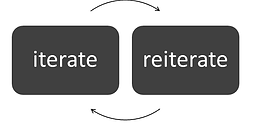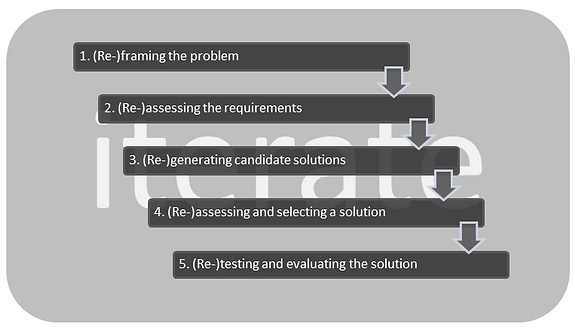ALAN LI
ENGINEERING PORTFOLIO


Several iterations for the design of the column in my beam bridge.
Iteration is key.
A quick Google image search on the engineering design process returns a variety of diagrams, each with various steps, but all sharing one main principle: that engineering design is a cycle, to be repeated and improved upon in every successive iteration. Here I present my simplified model of engineering design:
So when does this loop end? When the product hits the shelves? Maybe the better question to ask is if it should even end at all. Did Microsoft and Apple simply stop after their first iteration of Windows and iPhone were released? Engineering design is defined by this unending cycle; the moment we stop and allow ourselves to be satisfied with what we see is the moment we resign our engineering innovation.
What happens in each iteration?
It begins with the framing of a problem and the assessment of the required characteristics of a potential solution. Divergent solutions which meet the specified requirements are generated, and a single solution is then selected after evaluating each solution's performance against the specified criteria.
If the selected solution is tested and does not sufficiently address the problem, then the iteration process is repeated, but with refinements to the framing of the problem and the requirements from the failures of the previous iteration.
Even if the selected solution is deemed to sufficiently address the problem, the cycle is repeated, but at a more detailed level of design.
-
In my conceptual design report for a mechanical pencil that accepts variable lead size, it took several iterations of each step just to select a solution, which in turn gave rise to four detailed design decisions--what type of spring or what kind of material to use--each requiring their own design process.
Here is an illustration of the process, with examples incorporating the reiteration and refinement of each step:
(Re-)framing the problem:
The framing of a problem involves the conscious and subconscious approach to a problem, and the identification of the key aspects and scope of the problem: what's relevant and what isn't. Successful reframing requires challenging both conscious and subconscious assumptions and asking, is there another way of looking at this problem?
-
In the design brief my team authored about cold initial shower water, We initially framed the problem around heating up the water, which was both complex and expensive. In reframing the problem around simply preventing user contact with the cold water, the solution space was widened to allow for cheaper, more simple solutions.
(Re-)assessing the requirements:
Assessing the requirements to a problem involves establishing objectives with key stakeholders in mind, with a set of contraints which must not be violated, corresponding metrics as a way to measure them, and criteria as a way to compare different solutions.
Refining the requirements means reviewing the reframed problem and stakeholders and identifying deficiencies while providing evidence why something should be a constraint or criterion.
-
In the conceptual design report, my team found that it would be unlikely for a student to own a lead size for which he/she does not own a compatible pencil. A new stakeholder was thus added: drafters and artists who need to use different lead sizes. As a result, a new requirement was added as well: the proposed solution must not change the size of the lead inserted.
See conceptual design report for a full cycle of the engineering design process.
(Re-)generating candidate solutions:
Candidate solutions can be generated by several methods, including ideation techniques, functional decomposition or modification of an existing product.
With the refinement of requirements and the assessment and selection of solutions in each iteration, the solution space should be reduced to only one or two candidates each time. The purpose of the re-generation of solutions is to widen the solution space to allow for further iterations, keeping the aspects of the selected solutions that resulted in their selection, but creating a variation in the next level of detail.
-
The first set of solutions in the conceptual design report included pencils with a grinding mechanism which would convert different lead sizes into a single size. With the added requirement that the solution must not change the size of the lead inserted, this solution was eliminated. The second set of solutions was generated with this added requirement in mind.
(Re-)assessing and selecting a solution:
The comparison between candidate solutions is usually done with multiple-decision-criteria-analysis tools, such as a comparison matrix or a pugh chart. The solutions are scored based on the criteria specified, with metrics as a way to compare relative performance.
Multiple tools and iterations are usually needed to narrow down to a single solution.
(Re-)testing and evaluating the solution:
This is where functional prototypes are made and tested. Problems with the selected solution and details which need to be decided are noted and passed on to the next iterations, to be framed, assessed and evaluated in the successive cycle.

